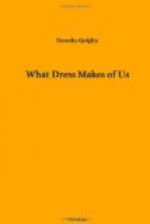[Illustration: No. 6]
For Short Faces.
The sisterhood who have short, chubby faces should, in a measure, observe certain rules that apply in a small degree to those who have heavy chins.
As may be observed even with a casual glance, the little short-faced woman depicted by No. 7, causes her round facial disk to appear much shorter than it really is by allowing her hair to come so far down on her forehead. She further detracts from her facial charms by wearing “water-waves.” Water-waves are scarcely to be commended for any type of face, and they are especially unbecoming to the woman who is conspicuously “roly-poly.” The round eyes, knobby nose, and round mouth are brought into unattractive distinctness by being re-duplicated in the circular effects of the hair. This mode of dressing the hair makes a short face look common and insignificant.
[Illustration: No. 7]
Do you not see that this type is immensely improved by the arrangement of the coiffure in No. 8? By combing her hair off her forehead her face acquires a look of alertness and intelligence, besides being apparently lengthened. She can wear her bang in soft crimps brushed back from her brow, if this plain arrangement is too severe.
[Illustration: No. 8]
For Eyes Set Too High.
A low forehead is supposed to be a sign of beauty in woman. The brows of the famous Venuses are low and broad. Perhaps for this reason many women wear their hair arranged low upon their foreheads. Whether the hair should be worn low on the brow depends chiefly on two things,—“the setting of the eyes, and the quality of the face.”
[Illustration: No. 8-1/2]
A good rule to observe is the artistic one, to the effect that “the eyes of a woman should be in the middle of her head.” That is, if an imaginary line were drawn across the top of the head and another below the chin, exactly midway between the two the eyes should be set.
The Japanese type of woman should carefully observe the foregoing hint.
Observe No. 8-1/2. Nature has not been artistic. The eyes are too near the top of the head. The defect is exaggerated and emphasized by the wearing of the hair low on the forehead. In some faces of this type the face is brutalized in appearance by this arrangement. The expression and whole quality of the countenance can be greatly improved by arranging the hair as shown by No. 9, which is the soft Pompadour style. The Duchess of Marlborough, formerly Consuelo Vanderbilt, frames her naive, winsome face, which is of the Japanese type, in a style somewhat like this. Her dark hair forms an aureole above her brow, and brings into relief the dainty, oval form of her face. Even simply brushing the hair off the forehead without crimp or roll will improve the appearance of this type of face and give it a better artistic balance.
[Illustration: No. 9]




